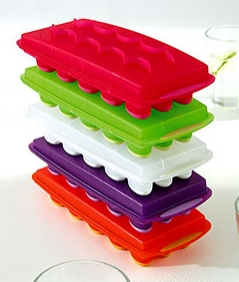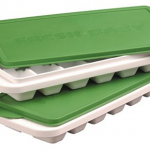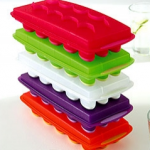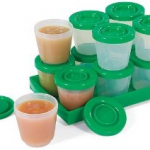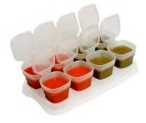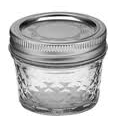A Guide to Pureeing: The Best Equipment to Make Baby Food
 Okay people, let’s talk equipment…that is…equipment needed to make your own organic baby food. I have buzzed, smashed, and blended my way through hundreds of my own baby food recipes at Little City Kitchen Co., and have learned which pieces of kitchen equipment work best along the way.
Okay people, let’s talk equipment…that is…equipment needed to make your own organic baby food. I have buzzed, smashed, and blended my way through hundreds of my own baby food recipes at Little City Kitchen Co., and have learned which pieces of kitchen equipment work best along the way.
Unless you plan on being a serious baby food maker, I don’t recommend going out and purchasing a bunch of expensive equipment.
The goal of this review is to talk about equipment that you hopefully already have in your home kitchen, or inexpensive things you can buy and use for other non-baby food related recipes once your little one moves beyond purees.
A few other references for those who are interested: I recently did a review of my favorite cooking methods for baby food (it’s not just steaming!), and a review of the best baby food storage containers on the market today.
I’m going to start at the top with the “ideal” tools, and work my way down. Don’t worry if you don’t have the top-of-the line items. Anything on this list will work, it just may take slightly longer (and slightly more work) to prepare the baby food.
 Food Processor: This is the most efficient and effective baby food-making tool a home cook can have. I use the Kitchen Aid 12 cup food processor…and I should confess here that I own four of them. Expect to pay $150-$200 for a good model.
Food Processor: This is the most efficient and effective baby food-making tool a home cook can have. I use the Kitchen Aid 12 cup food processor…and I should confess here that I own four of them. Expect to pay $150-$200 for a good model.
Pros: Smoothest puree texture, very efficient and fast, large bowl capacity, easy to use, very versatile (I make hummus every week!)
Cons: On the expensive side, more time consuming to clean, takes up space
 Blender: Since many home cooks don’t have a food processor, I’ve found a blender is a great alternative. I use the Kitchen Aid 5-Speed model for around $100. You want a pretty powerful one, but if you have a cheaper model, that’s fine, it just means you may need to work a little harder.
Blender: Since many home cooks don’t have a food processor, I’ve found a blender is a great alternative. I use the Kitchen Aid 5-Speed model for around $100. You want a pretty powerful one, but if you have a cheaper model, that’s fine, it just means you may need to work a little harder.
Pros: You probably already have one, they puree relatively well
Cons: Requires a few stop/starts and a spatula to keep scraping down the sides, not quite as efficient as a food processor
 Immersion blender: If you’re a fan of making pureed soups, then you may already be the proud owner of an immersion blender. These nifty little things have a blender blade on the end of a wand that goes right into the bowl of food and liquid on your stove. I have a Kitchen Aid immersion blender that cost me around $80.
Immersion blender: If you’re a fan of making pureed soups, then you may already be the proud owner of an immersion blender. These nifty little things have a blender blade on the end of a wand that goes right into the bowl of food and liquid on your stove. I have a Kitchen Aid immersion blender that cost me around $80.
Pros: Small appliance, super-easy cleanup, purees soft vegetables pretty well
Cons: Doesn’t work well on harder veggies, takes longer to puree than a food processor or blender
 Food Mill: Think of a bowl with a colander-like bottom and a crank that pushes food through the holes. Food mills can work well for softer, well cooked foods like applesauce, sweet potato, and butternut squash.
Food Mill: Think of a bowl with a colander-like bottom and a crank that pushes food through the holes. Food mills can work well for softer, well cooked foods like applesauce, sweet potato, and butternut squash.
I have very sturdy stainless steal one from Cuisipro for around $90, but most baby stores sell a plastic version for around $15. Not a great piece of equipment, but it can certainly work well if you don’t have a blender.
Pros: No electricity needed, plastic ones are inexpensive, works on soft foods
Cons: Not a very smooth consistency achieved, not extremely useful outside of baby food…unless you really like homemade applesauce!
 Potato Masher: Trust me folks, everyone can make baby food! If nothing else, you can always rely on a handy potato masher combined with a little elbow grease to make food for your kiddo.
Potato Masher: Trust me folks, everyone can make baby food! If nothing else, you can always rely on a handy potato masher combined with a little elbow grease to make food for your kiddo.
Check out five easy and inexpensive baby food recipes using nothing but a potato masher. My fav one is actually a “bean masher” (which I prefer over a potato masher) for a measly $2.00 from WalMart. You can usually find them at Mexican or Hispanic food stores as well.
Pros: very inexpensive, small, easy to clean
Cons: takes time and energy to mash, don’t get a very smooth consistency
So you’ve learned how to cook baby food, what equipment is needed to puree it, and finally, how best to store it. Now off you go into the kitchen to whip up some goodies for the little ones. Please feel free to leave a comment with your own baby food-making experiences!!






